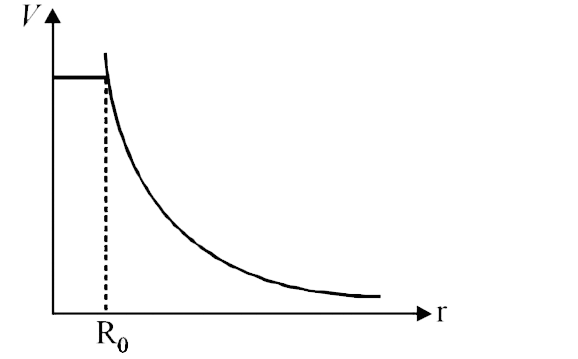The Bohr model for the H-atom relies on the Coulomb's law of electrostatics . Coulomb's law has not directly been varified for very short distances of the order of angstroms. Suppos-ing Coulomb's law between two oppsite charge +q1,−q2 is modified to ∣∣→F∣∣=q1q2(4πε0)r21r2,r≥R0
=q1q2(4πε0)r21R20(R0r)ε,r≤R0
Calculate in such a case , the ground state enenergy of H-atom , if ε=0.1,R0=1Å
We are given ∣∣→F∣∣=q1q2(4πε0)1r2,r≥R0∣∣→E∣∣=q1q2(4πε0)1R20(R0rε)ε,r≤R0
∈=0.1,R0=1Å.
Let ∈=2+δ.
∴F=q1q2(4πε0)Rδ0r2+δ=∧Rδ0r2+δ for r≤R0
Where ∧=q1q24πε0=9×109(1.6×10−19)2=23.04×10−29
So, F=mv2r=∧Rδ0r2+δorv2=∧Rδ0mr1+δ.......(i)
(i) As mvr=nh,r=nhmv Using (i), r=nhm⎡⎢⎣m(∧(Rδ0)]1/2r12+δ2
Solving this for r, we get rn=[n2h2m∧Rδ0]11−δ
for n=1,r1=[n2h2m∧Rδ0]11−δ=[1.052×10−68(9.1×10−31)(23.04×10−29)1019]12.9=8×10−11m=0.08nm<0.1nm
(ii) form vn=nhmrn=nh(∧Rδ0n2h2)11−δ for n=1,v1=hmr1=1.44×106m/s
(iii) K.E.=12mv21=9.43×10−19J=5.9eV P.E. (tillR0)=−∧R0
P.E. form R0 to r=∧Rδ0∫rR0drr2+δ=∧Rδ0−1−δ[1r1+δ]rR0=−∧Rδ01+δ[1r1+δ−1R1+δ0]=−∧1+δ[Rδ0r1+δ−1R0]
P.E. =−∧1+δ[(Rδ0r1+δ−1R0+1+δR0]=−∧−0.9[R−1.90r−0.9−1.9R0]=2.3×10−280.9[(0.8)0.9−1.9]joule=−17.3eV
∴ Total energy =(−17.3+5.9)eV=−11.4eV
Topper's Solved these Questions
- ATOMS AND NUCLEIBOOK - PRADEEPCHAPTER - ATOMS AND NUCLEIEXERCISE - Very short question 1
1 Video
- ATOMS AND NUCLEIBOOK - PRADEEPCHAPTER - ATOMS AND NUCLEIEXERCISE - Very short question 4
1 Video
- ATOMS AND NUCLEIBOOK - PRADEEPCHAPTER - ATOMS AND NUCLEIEXERCISE - Long question 15
1 Video
- COMMUNICATION SYSTEMSBOOK - PRADEEPCHAPTER - COMMUNICATION SYSTEMSEXERCISE - MODEL TEST PAPER-2
9 Videos
Similar Questions
The Bohr model for the H-atom relies on the Coulomb's law of electrostatics . Coulomb's law has not directly been varified for very short distances of the order of angstroms. Suppos-ing Coulomb's law between two oppsite charge +q1,−q2 is modified to ∣∣→F∣∣=q1q2(4πε0)r21r2,r≥R0
=q1q2(4πε0)r21R20(R0r)ε,r≤R0
Calculate in such a case , the ground state enenergy of H-atom , if ε=0.1,R0=1Å
View Solution41.Self energy of conducting sphere of radius r carrying charge is (1) Q28πε0(r) (2) Q24πε0(r) (3) Q26πε0(r) (4) Q22πε0(r)
View Solution
Knowledge Check
The electrostatic force between two point charges q1 and q2 at separation r is given by F=k.q1q2r2. The constant k
ADepends upon system of units onlyBDepends upon medium between the chargesCDepends on both 1 and 2DIs independent of both 1 and 2A spherical symmetric charge system is centered at origin. Given, Electric potential
V=Q4πε0R0(r≤R0), V=Q4πε0r(r>R0)
 A(a) Within r=2R0 total enclosed net charge is QB(b) Electric field is discontinued at r=R0C(c) Charge is only present at r=R0D(d) Electrostatic energy is zero for r<R0
A(a) Within r=2R0 total enclosed net charge is QB(b) Electric field is discontinued at r=R0C(c) Charge is only present at r=R0D(d) Electrostatic energy is zero for r<R0
If Coulomb's law involved 1r3 (instead of 1r2), would Gauss's law still be true?
View SolutionThe vector form of Coulomb's law is (A) →F=14πε0⋅q1q2|→r|3→r (B) →F=14πε0⋅q1q2r3 (C) →F=14πε0⋅q1q2r2→r (D) →F=14πε0⋅q1q2r→r
View SolutionThe vector form of Coulomb's law is (A) →F=14πε0⋅q1q2|→r|3→r (B) →F=14πε0⋅q1q2|→r|3 (C) →F=14πε0⋅q1q2r2→r (D) →F=14πε0⋅q1q2r→r
View SolutionEvaluate ∫r2r1(r−ηq0qr2)dr
View SolutionA charge q1 is placed at the centre of a spherical conducting shell of radius "R" .Conducting shell has a total charge q2 .Electrostatic potential energy of the system is (A) q21+2q1q28πɛ0R (B)q22+2q1q28πɛ0R (C) q21+q1q28πɛ0R (D) q22+q1q28πɛ0R
View SolutionWrite an expression for potential at a point P −→(r) due to two point charges q1andq2 at →r1and→r2 respectivley.
View Solution